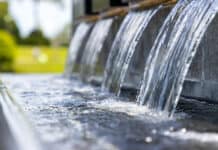By Stephen Lewis
Our shared Earth may be covered in water, but less than 1% of it is accessible, and far less than that is potable. In some locations, up to 90% of sewage is discharged into waterways without treatment, turning what could be usable water into contaminated so-called “black water.”

In 2018, drought conditions in the U.S. were at their worst level in almost four years, while an apparent El Niño event is currently bringing punishing heat and drought to the Southern Hemisphere. Clearly, the global water problem is likely to get worse before it water conservation gets better.
Given the shrinking supply, municipalities have begun to increase water’s price tag, making it a challenge for lower-income residents to enjoy water security. And in a little more than a decade, five billion people will call urban areas home. When we reach that pivot point, water demand will exceed supply and continue in that direction. It’s a dire situation, and regrettably, most governments are woefully unable to meet the challenge. For that reason, facilities of all sizes may have to lead the way when it comes to meaningfully, mindfully using the small percentage of potable water we can access.
High Cost of Ignoring Water Scarcity
Organizations that ignore this massive water problem won’t only be passing up an opportunity to lead the fight on an important social issue, they’ll also be hurting themselves.
Skyrocketing water costs will eat away at their bottom lines year after year. If they expect to keep raising their prices to cover rising utility bills, they may discover they price their target customers out of their offering. And that’s to say nothing of the risk to a facility’s public image — no one wants to be skewered by a public that increasingly values environmental stewardship.
Fortunately, some are embracing initiatives such as the newly emerging Science-Based Targets and adopting smarter water management practices, including high-profile players like Procter & Gamble. The well-known global enterprise has taken on water protection as a permanent project. P&G has announced a three-pronged approach to mitigate water stress in 40 communities where it operates manufacturing plants, and at those locations, P&G is seeking partners to share water in coordinated, innovative ways.
Although not all players are able to take the strong stance of a P&G, the private sector can make the topics of water conservation, water preservation, and water use education part of common corporate culture. Facility managers can contribute to the cause by rethinking the way they use water as part of their operations in three strategic areas.
1. Water Consumption in Restroom Facilities
Installing low-flush toilets and zero-water urinals may seem like modest moves toward lowering water usage, but they can lead to widespread positive changes. Low-flow toilets require around a quarter of the water of traditional, older toilets, saving gallons of water with every flush. Similarly, waterless urinals can help create a closed-loop system that requires almost no water, with the exception of urinal sanitization. Once collected and appropriately treated, pure urine can be used to create fertilizers for farms.
On a slightly smaller but still important scale, water-efficient faucets — such as those with motion sensors that stop excessive running of water — can reduce water use by around 20%. Liquid hand sanitizers may also provide excellent alternatives to hand washing in private- or public-facing bathroom facilities.
2. Water Collection and Recycling
As long as rainwater is not used for potable purposes, it can be reclaimed in many different ways, such as providing “gray water” for use in toilet flushing. And when collected in barrels or from rooftops, rainwater can become a water source for landscape irrigation and manufacturing processes.
Facilities may have more water available than they might have guessed; managers just need to creatively imagine how to maximize their supplies. For example, one Cimarex Energy manager boasts that the company’s business objective is to rely on chemicals, filtration, and oxidation to make better use and reuse of water in its processes.
3. Green Cleaning Practices
Water is consistently used for janitorial and sanitation purposes in buildings, but in many cases, cleaning professionals could obtain the same level of hygiene without wasteful water practices. Simply changing hose nozzles or outfitting hoses with manual-release spray gun heads can cut back on water waste and improve green cleaning programs.

In addition, dry carpet cleaning processes that depend upon encapsulation — not water — can keep carpeting clean while requiring almost no water to get the job done. An added benefit to this environmentally friendly practice is that carpets cleaned through encapsulation methods tend to last years longer because of reduced exposure to bacteria-breeding ground moisture.
Facility managers serious about monitoring water usage may want to conduct a water audit to pinpoint areas of water misuse and determine how much money they could save by making a few adjustments. Planet Earth has delivered us with a bounty of natural resources, including a workable amount of potable water. If every corporation took water stewardship to heart, we could easily push back against the looming water shortage crisis. All it takes is that first step in the right direction.
 Lewis is the technical director at milliCare, where he manages all equipment, methods, and products for the floor and textile cleaning company. Stephen, a certified senior carpet inspector and an IICRC master textile cleaner, has proudly served milliCare for almost 30 years.
Lewis is the technical director at milliCare, where he manages all equipment, methods, and products for the floor and textile cleaning company. Stephen, a certified senior carpet inspector and an IICRC master textile cleaner, has proudly served milliCare for almost 30 years.





















![[VIDEO] Collect Asset Data at the Speed of Walking a Building](https://facilityexecutive.com/wp-content/uploads/2024/02/maxresdefault-324x160.jpg)